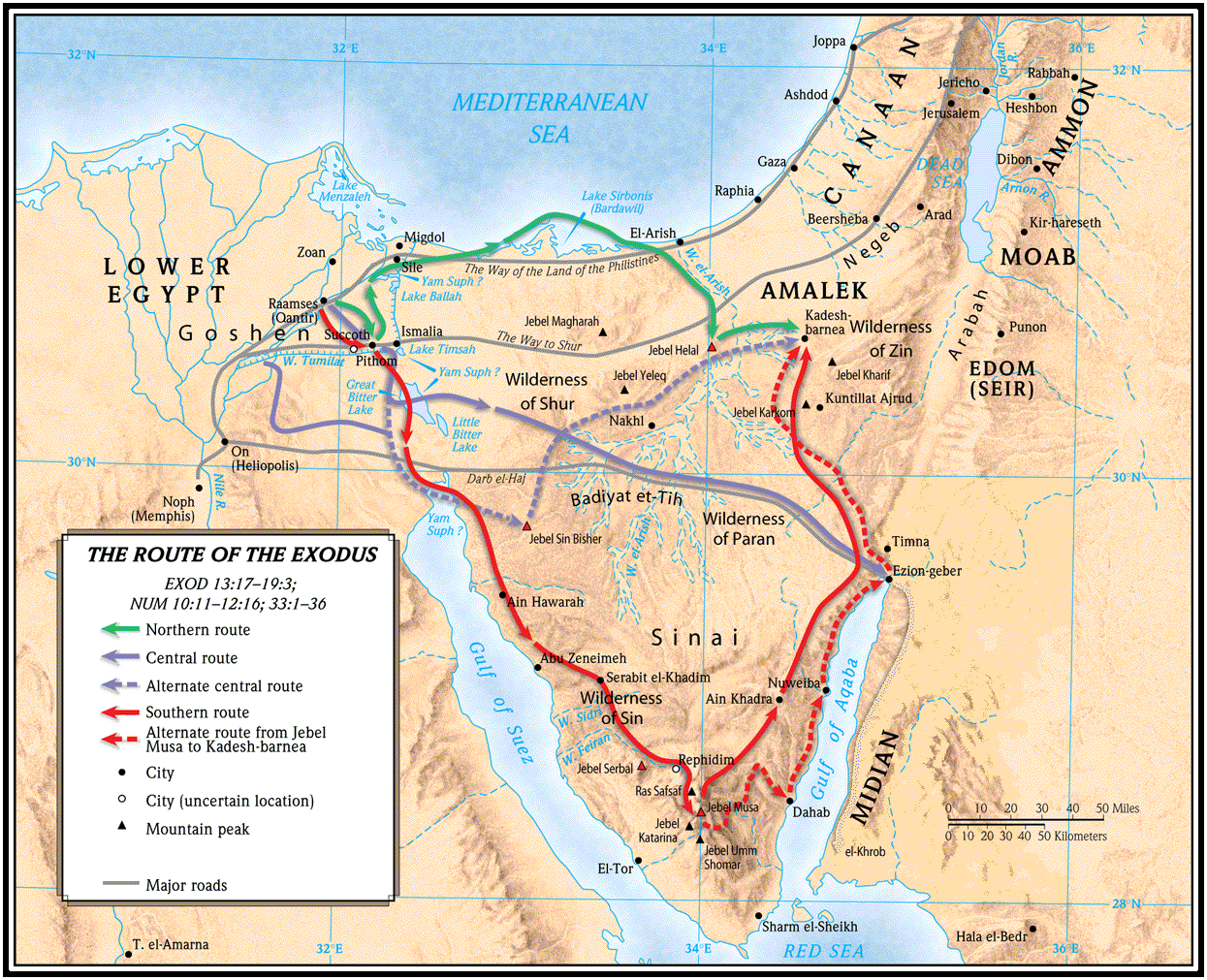Yam Suph — Red Sea or Sea of Reeds
The Hebrew words Yam Suph are always translated either “Red Sea” or “Sea of Reeds” referring to the sea the Elohim of the children of Israel split at the Exodus from Egypt. The meaning of Yam Suph has been lost for us and “Red Sea” and “Sea of Reeds” may not be quite correct, as we will examine this below. But why is it important to find the correct translation of Yam Suph where Elohim performed His last plague on Egypt and saved His children from slavery? It is important because the correct translation may answer questions on an enigmatic book quoted in the Scripture but considered by many scholars lost throughout centuries, as other books were. But for more information on these books refer to the article “The lost books of the Bible“.
What suffices to say for now is that this mysterious book is not just mentioned in the Scripture but a verse from it is quoted proving that the book must have been known. To make the things even more enigmatic this verse is so encrypted that it has been puzzling the Jewish scholars for centuries. What this verse wants to say to us will be a subject of another study. But before that we need first to find what Yam Suph (translated either “Red Sea” or “Sea of Reeds”) means. The answer to this question may lead us to the book, if YHVH wills it.
What divided Yam Suph?
We know from the Exodus story is that YHVH Elohim “caused the sea [Yam Suph] to go back” by the agency of “a strong wind”. We read from Exodus thus,
And Mosheh stretched out his hand over the sea. And Yehovah caused the sea to go back by a strong east wind all that night, and made the sea into dry land, and the waters were divided. (Exo 14:21)
Contrary to the scene of the splitting of Yam Suph in the popular movies, the Red Sea was not split by the hand of Mosheh, nor did it split right away but only after the strong east wind was blowing “all night” and it was split at the end of the night causing the Israelites to begin marching through it on dry land. What we need to keep in mind in our study is that YHVH caused Yam Suph to part by a strong wind. The first time the term Yam Suph is used in the Scripture is in the plague of the locusts, as we read thus,
And Yehovah turned a very strong west wind, which took the locusts away and blew them into Yam Suph. Not one locust was left within all the border of Egypt. (Exo 10:19)
Here Yam Suph is rendered “Red Sea” in JPS and KJV, but “See of Reeds” in other translations. What we should note though is that that very strong wind was strong enough to blow the locust away off the land of Egypt. Egypt at that time was the world’s strongest empire that spread in a vast territory. Therefore, we can deduce that the strong wind was so huge that covered the entire Egypt and cast all locust in Yam Suph so that not one locust remained from coast to coast in Egypt. That strong storm must have been what we call today “hurricane”.
Red Sea of Sea of Reeds?
In the verse above (Exo 10:19), יָם yam, means “sea” and in conjunction with סוּף suph is commonly translated “Red Sea” or “See of Reeds”, wherein the former is the prevalent rendering today of the water body between Africa and Arabia. But what is the meaning of the Hebrew word suph; does it mean “red” or it means “reeds”? First, we should note that the Hebrew word suph in Yam Suph is a noun and used always in singular, while the translations “red” is an adjective and “reeds” is a noun in plural.
The Hebrew word for “red” is אָדֹם adom, which also means “ruddy”. It comes from the primitive verb אָדַם adam, which means to show blood (in the face), that is, flush or turn rosy, be red (ruddy). אֲדַמְדָּם adamdam, is a reduplicated word from adam that means reddish, and אֹדֶם odem, is redness. From adom comes the name אֱדֹם edom, red (see Gen 25:25), Edom, the elder twin-brother of Ya’acov; hence the region occupied by him: Edom, Edomites, Idumea. A related word to adom is adam which means ruddy, that is, a human being or mankind, and Adam, the name of the first human. Another related word is אֲדָמָה adamah, soil (from its general redness), country, earth, ground, and land.
With that being said, we find no etymological link between the adjective אָדֹם adom and the noun סוּף suph. The word סוּף suph, on the other hand, is understood to mean reed, rush, or any water plant in that form. Hence, Yam Suph is also translated “Sea of Reeds” after the native vegetation that grew in the marshlands of ancient Egypt. “Sea of Reeds” [not necessarily wrong] translation of Yam Suph has led the historians to erroneously associated the sea with what is known today “the Suez Canal” as the commonly accepted crossing of the sea during Israel’s exodus from Egypt. It is believed by most of the scholars that the waters of this Yam Suph are the waters the Creator parted by His last plague on Egypt. The conflict of this translation, however, is that back then there was no sea but marshlands in the suggested crossing, and as we know, the Suez Canal was built by the French thousands of years later and even today it is more of canal rather than sea.
So, back in ancient times the Suez Canal did not exist and today it links the northwestern arm of the Red Sea to the Mediterranean Sea. In the article “Where is the real Mount Sinai?” we studied that the real crossing of Israel during the Exodus from Egypt was not marshlands (today the Suez Canal) but the northeastern arm of Red Sea, between the Sinai Peninsula (Egypt) and Saudi Arabia, also known as Gulf of Akaba. We also studied that the real Mount Sinai was not in what is known today as the Sinai Peninsula in Egypt but, as Apostle Shaul has stated, it is in Arabia.
Apart from “Yam Suph”, the noun suph is used only in Exo 2:3, Isa 19:6, and Jon 2:5 with its meaning of tall woody perennial grasses with hollow slender stems: reeds or any water plants that twine or twist together into or around something.
For instance, baskets of wicker were a work made of interlaced slender branches of tall marsh plant in the Nile River whose long flat leaves are used today for making also mats and chair seats. Therefore, we may say that the rendering of Yam Suph as “Red Sea” has no justification in the Hebrew language and context, even though it is the most common one, and “Sea of Reeds” appears to be the correct one. Or perhaps, “Red Sea” is also a legitimate rendering of Yam Suph given after the red and ruddy color of the reeds in the Nile delta.
What is suphah?
Suph is the same kind of reeds Mosheh’s mother used to make a wicker basket that resembled the vegetation as a perfect camouflage to hide her son in the reeds by the bank of the Nile River. We read in Hebrew and English thus,
וְלֹא־יָכְלָה עוֹד הַצְּפִינוֹ וַתִּקַּח־לוֹ תֵּבַת גֹּמֶא וַתַּחְמְרָה בַחֵמָר וּבַזָּפֶת וַתָּשֶׂם בָּהּ אֶת־הַיֶּלֶד וַתָּשֶׂם בַּסּוּף עַל־שְׂפַת הַיְאֹר׃
When she could hide him no longer, she got a wicker basket (גֹּמֶא) for him and caulked it with bitumen and pitch. She put the child into it and placed it in the reeds (סוּף suph) by the bank of the river. (Exo 2:3)
The medieval Tanak commentator Rashi (Shlomo Yitzchaki, 1040 – 1105) said in his comments on Exo 2:3 that, in the phrase ותשם בסוף “and she put it in the flags”, סוף suph has the same meaning as “a wicker basket”. The idea is that as the reeds twist together in a wicker basket, so does suph.
Another example of the word suph, used with the meaning of twining and twisting, which will bring us closer to the mysterious book, is found in Jon 2:4-6 (Jon 2:3-5 in the Christian Bibles). We read thus,
For You threw me into the deep, into the heart of the seas, and the waters surrounded me. All Your breakers and Your waves passed over me. So I said, “I have been driven away from Your eyes. … Waters encompassed me, unto life, the deep closed around me, reeds (suph) were twined around my head. (Jon 2:4-6)
Yonah (Jonah) in his flee from Elohim on a ship was caught up in a strong storm. To save the ship, the sailors threw Yonah overboard and he descended to the depth of the sea. The text further says “the waters covered him” as the waves closed up on him and suph twined around him. And YHVH showed him the place from where the breakers of the sea and its waves go out, verse 4(3), and the pillars of the Earth in its foundation, verse 7(6). So, Yonah was caught in the waters that surrounded him, the reeds (but in Hebrew suph) twined around him and threw him on the bottom of the sea.
In the parallelism of “the waters” and “the reeds”, we find that “reeds” (suph) emphasize the waters Yonah was caught in. Therefore, it would be inappropriate in this particular occasion to render suph (singular) as “reeds” (plural) since the plain context does not allow such a rendering because it is unknown that reeds can grow in salt water much less to be found on the bottom of sea. Hence, we can deduce that suph is used here as a metaphor to present something that twists or twines, i.e. in this case the waters that twined around Yonah. In other words, the original meaning of suph being a noun appears to be something that twines or twists. What we derive from the text is that Yonah descended to the bottom of the sea in what appears to be a whirlpool, i.e. suph of waters. With that being said, we are coming closer to decipher the encrypted verse in the mysterious book quoted in the Torah.
The next word in question, which appears in this book, is סוּפָה suphah. Suphah comes from the primitive root סוּף suph, to mean “to snatch away” in a sense of to terminate, consume, have an end, and perish. With its literal meaning of snatching away suph is found in Isa 66:17 and Jer 8:13. This is the same word used in Yam Suph, commonly translated either “Red Sea” or “Sea of Reeds”. With the meaning of snatching away and consuming, the noun סוּפָה suphah, is used to mean a whirlwind, hurricane, storm, or tempest, since all these natural events bring destruction or termination by snatching away in air like in a tornado or hurricane. With this literal meaning of “whirlwind”, suphah can be found in Pro 1:27, Pro 10:25, Isa 5:28, and Isa 17:13.
Woe to the uproar of many people who make a noise like the roar of the seas, and to the rushing of nations that make a rushing like the rushing of mighty waters – nations rushing like the rushing of many waters. But He shall rebuke them, and they shall flee far away and be chased like the chaff of the mountains before the wind, like whirling dust before the whirlwind (suphah). (Isa 17:12-13)
The concept of suphah as a strong tornado and even hurricane, this prophecy is giving us, is quite clear just by reading the descriptive words: the roar of the seas, the rushing of mighty waters, the wind like whirling dust before the whirlwind. To emphasize the destructive nature of supha “whirlwind”, we find a related word to סוּף suph which is סוֹף soph, meaning a termination, conclusion, end. In other words, as סוּף suph is something that twines and twists, so is סוּפָה suphah, a twister: a localized and violently destructive windstorm occurring over land or water characterized by a funnel of twisting air extending downwardly. Or, we may call suphah a hurricane, tornado or waterspout. In support of this interpretation comes the etymology of the word סוּפָה suphah, namely, being the feminine form of the masculine סוּף suph. There are many Hebrew words that form the feminine form by having added the suffix ה hey. The example is the word שַׂר sar, which means master, principal, ruler, steward, and its feminine form is שָׂרָה sarah, a mistress, female noble, lady, princess, and queen. This is also the name for Sarah, our matriarch, the wife of the patriarch Avraham. Another example is the synonym of סוּף suph and סוּפָה suphah, whose masculine form is סַעַר sa’ar and the feminine form סְעָרָה se’arah with the same meaning: a hurricane, storm, tempest, whirlwind.
The enigmatic book
In conclusion, since both words in Yam Suph are nouns, yam being “sea” and suph, a twister, storm, we may render Yam Suph as “Sea of Storm” or “Sea of Twister”. And this will be adequate rendering of Yam Suph where YHVH Elohim parted its waters by a powerful storm. And perhaps, that was the reason for giving this name. When Mosheh wrote the Book of Exodus, but in Hebrew Shemot (Names), he named the sea after the miracle YHVH Elohim did before the children of Israel splitting the waters by a strong storm. With the knowledge we obtained in this study, namely, Yam Suph is “Sea of Storm” we can proceed to the next article in which we will attempt to explain the concise verse from the mysterious book quoted in the Torah: The Book of the Wars of Yehovah.
Knowledge known to only a few will die out. If you feel blessed by these teachings of Time of Reckoning Ministry, help spread the word!
May we merit seeing the coming of our Mashiach speedily in our days!
This page contains sacred literature and the Name of the Creator. Please, do not deface, discard, or use the Name in a casual manner.



